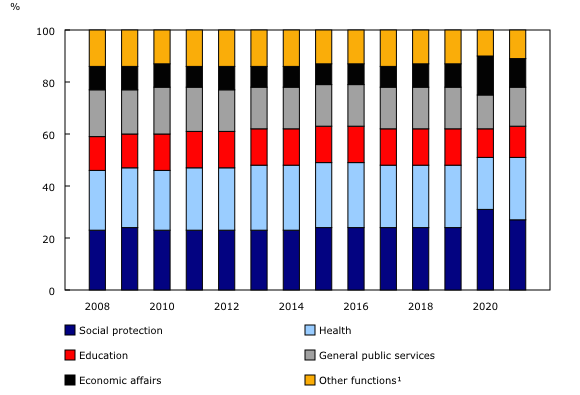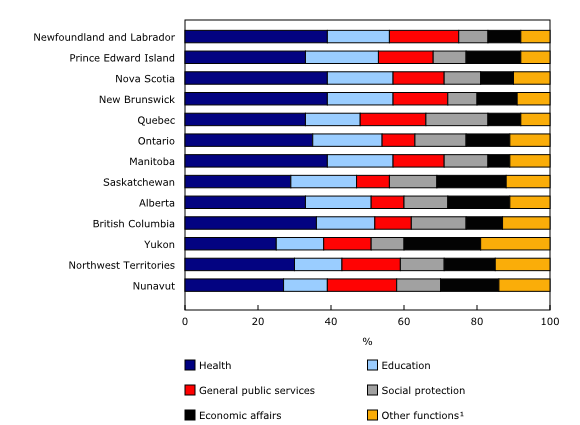Government spending by function, 2021
Released: 2022-11-25
Spending by all levels of government in Canada declined in 2021 after reaching an all-time high of over $1 trillion in 2020 because of COVID-19 pandemic response spending. Spending decreased by 7.8%, or $81.9 billion, in 2021, with total spending at $969.5 billion. Government spending in 2021, although a decline from the previous year, remained higher than pre-pandemic spending levels, with $969.5 billion in 2021 well above $799.7 billion in 2019.
Social protection and economic affairs were the largest contributors to spending decreases in 2021. Governments in Canada spent $9,616 per person in 2021 in these two categories, compared with $12,727 in 2020. Health spending, which rose 14.2% in 2020, increased by another 6.5% in 2021.
Unemployment spending declines following spike in 2020
The consolidated Canadian general government—that is, the federal, provincial, territorial, local and other government entities combined—decreased spending on social protection by 19.2% in 2021, to $261.0 billion. Social protection remained the largest expense of the Canadian general government, at over one-quarter (26.9%) of total spending.
Social protection includes programs such as Old Age Security, family benefits, disability payments and unemployment benefits. The decrease in 2021 (-$62.0 billion) was driven by lower spending on unemployment (-$67.6 billion)—which was largely because of the decline in federal pandemic response programs such as the Canada Emergency Response Benefit and the subsequent Canada Recovery Benefit.
Canada Emergency Wage Subsidy tapers off in 2021
Spending on economic affairs—which refers to economic activities such as agriculture, energy, mining or transport—fell 31.8% from 2020 to $110.6 billion. This category was the second-largest contributor to decreased government spending in 2021. The 2021 decrease was attributable to spending on general economic, commercial and labour affairs, which decreased 60.2% from $99.9 billion in 2020 to $39.7 billion in 2021. The Canada Emergency Wage Subsidy was responsible for this decrease as payments under the program declined in 2021.
Health care accounts for over a third of provincial, territorial and local government spending
Spending on health care by provincial, territorial and local governments combined grew 4.5% in 2021, maintaining its position as their largest expense, at over one-third (34.5%) of their total spending.
Per capita spending on health care was the highest provincially in Newfoundland and Labrador ($6,913), Manitoba ($6,162), and New Brunswick ($5,929). The lowest health care expenses per capita were in Prince Edward Island ($5,209), Alberta ($5,340) and Ontario ($5,358).
Provincially, hospital services accounted for the largest proportion of health care expenses, at two-thirds (65.7%), followed by outpatient services (15.4%) and medical products, appliances and equipment (7.1%).
Economic affairs spending driven by agriculture and transport
Total provincial, territorial and local government spending on economic affairs rose 16.0% to $73.5 billion in 2021. This increase in economic affairs (+$10.1 billion) accounted for 29.5% of the total spending increase by provincial, territorial and local governments. This increase was largely attributable to higher spending on agriculture, forestry, fishing, and hunting (+$6.3 billion) and transport (+$3.2 billion).
The increase in spending on agriculture, forestry, fishing, and hunting was driven by the provinces of Alberta (+$2.7 billion) and Saskatchewan (+$2.7 billion). In both provinces, their respective provincial crop insurance corporation paid out unusually high indemnities caused by unfavourable growing conditions in 2021, namely drought.
Transport spending increases were because of Ontario (+$1.8 billion) and British Columbia (+$1.1 billion). The growth in Ontario was mainly attributable to transfers for "The Ontario Line," a new Toronto subway line that is under construction. British Columbia's increased transport spending was primarily because of costs associated with the removal of tolls on the Golden Ears Bridge.
Quebec increases social protection measures in 2021
In 2021, provincial and local governments increased their spending on social protection by $5.8 billion. Quebec was responsible for the majority of this increase (+$5.3 billion), primarily because it issued a one-time cost of living tax credit.
Among provincial and local governments, spending on social protection on a per capita basis was highest in Quebec ($3,027) and Saskatchewan ($2,648), and lowest in New Brunswick ($1,260) and Newfoundland and Labrador ($1,342).
Note to readers
The Canadian Classification of Functions of Government (CCOFOG) organizes government expenses into their main socioeconomic functions. This information provides an important picture of how governments spend money and the role governments play in delivering services.
The CCOFOG is a variant of the international functional expenditure classification that was developed by the Organisation for Economic Co-operation and Development. The CCOFOG replaced the Financial Management System that was used by Statistics Canada until 2008.
Currently, CCOFOG data exclude the acquisitions of non-financial assets and the consumption of fixed capital expenses. Future data improvements may include the functionalization of capital expenditures and the consumption of fixed capital.
The consolidated provincial, territorial and local government (PTLG) estimates are recommended for provincial and territorial comparisons since there can be different delineations of responsibilities between levels of government in various jurisdictions. These estimates combine provincial and territorial governments, health and social service institutions, universities and colleges, municipalities and other local public administrations, and school boards, while removing interparty transactions. The consolidated Canadian general government estimates combine the federal government data with PTLG data. They exclude data for the Canada Pension Plan and the Quebec Pension Plan, and for federal and provincial government business enterprises.
The constitutional framework of PTLGs in the territories differs from the framework in the provinces. This leads to differences in the roles and financial authorities of government. These differences, as well as other geographic, demographic and socioeconomic dissimilarities between the North and the rest of Canada, give rise to significant differences in government finance statistics.
Since the size of PTLG estimates varies significantly across jurisdictions because of different population sizes, per capita data are used for expense comparisons. Per capita data are based on population estimates for Canada, the provinces and the territories, available in Table 17-10-0009-01.
Annual data correspond to the end of the fiscal year closest to December 31. For example, data for the federal government fiscal year ending on March 31, 2022, (fiscal year 2021/2022) are reported as the 2021 reference year.
Products
The infographic "Overview of Government Spending by Function, 2021/2022," which is part of Statistics Canada – Infographics (11-627-M), is now available.
The Canadian Classification of Functions of Government classification structure and descriptions are now available under the related information module of the Statistics Canada website.
Additional information can be found in the Latest Developments in the Canadian Economic Accounts (13-605-X). The User Guide: Canadian System of Macroeconomic Accounts (13-606-G) is also available. This publication has been updated with Chapter 9. Government Finance Statistics.
Contact information
For more information, or to enquire about the concepts, methods or data quality of this release, contact us (toll-free 1-800-263-1136; 514-283-8300; infostats@statcan.gc.ca) or Media Relations (statcan.mediahotline-ligneinfomedias.statcan@statcan.gc.ca).
- Date modified:


